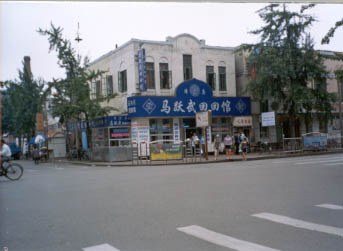

One of the main streets in Dandong city. This is a Moslim restaurant. I had a bowl of wonton soup and some pickles for only 4 Chinese yuan ($.50)
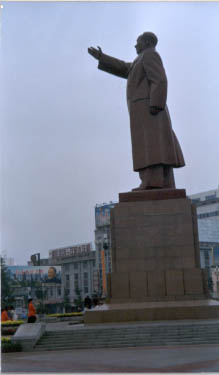
Mao's statue in city square facing east. Far to the left lower side is a portrait of Deng Xiaoping.
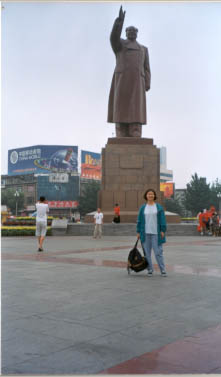
I am in front of Mao's statue.
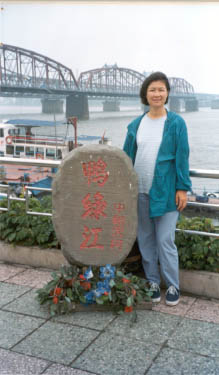
Along side of the Yalu River on the Chinese side. Behing me is the broken bridge and the one behind the broken bridge is the new one in use now to connect North Korea and China.
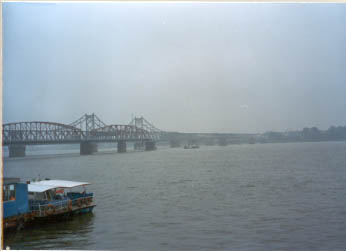
Another picture to look at the broken bridge in the Yalu River.
The picture was taken on the Chinese side of the river.
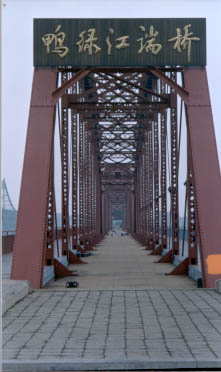
The enterance of the broken bridge. The Chinese characters read as "Yalu River Edged Bridge." The Chinese government did not like the word "broken" (duan4). So a linguist suggested the use of another Chinese character which has the similar sound as "broken" but a different meaning. "Duan1" means the edge or end, which the Chinese can also interpret as being broken to have an edge. Therefore, the broken bridge was renamed as the "edged bridge," just to be more intellectual.
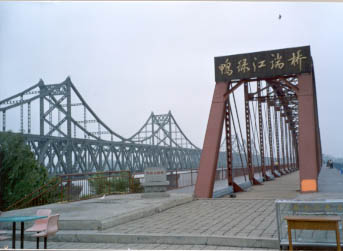
Another look at the "Yalu River Edged Bridge" with a new bridge side by side. Any Chinese can pay an admission fee of 10 Chinese yuan ($1.25) to walk through the broken bridge to the endge in the middle of the Yalu River.
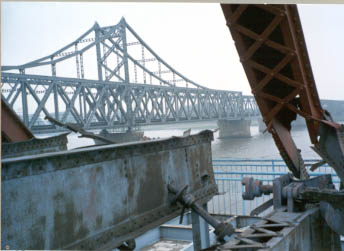
The is the edge of the broken bridge. The damaged steel parts of the bridge are still what they were 50 years ago. The northern part of the bridge was bombed off by the U.S. air raids during the Korean War.
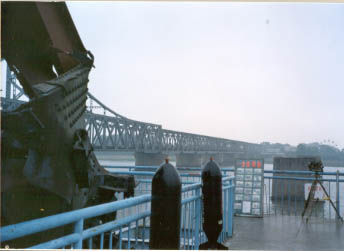
The two bombers are photo costums for tourists. This is the end of the broken bridge. The stools of the bridge on the North Korean side of the Yalu River are still standing in the water.
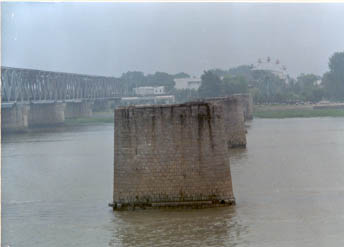
The stools of the broken bridge that was bombed off are still standing in the water north of the Yalu River. The further side is North Korea. I took the bus to cross the Yalu River into North Korea by going through the bridge to the left.
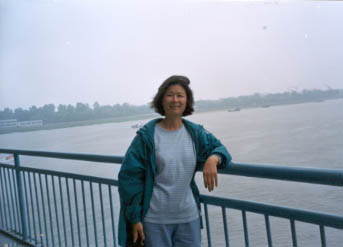
I am on the edge of the broken bridge. Behind me is North Korea. The day I was there was very foggy and humid.
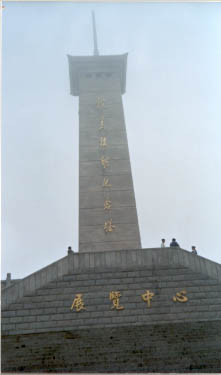
The Memorial of the War to Resist America and Aid Korea in Dandong city
in China. Underneath is a museum. The Korean War in western
term is known in China as The War to Resist America and Aid Korea.
The Chinese do not use the term the Korean War as popularly known
in the West.
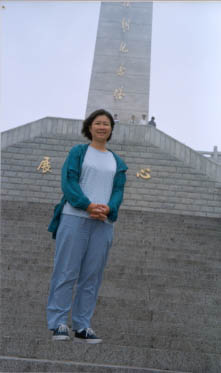
I am in fron of the Memorial.
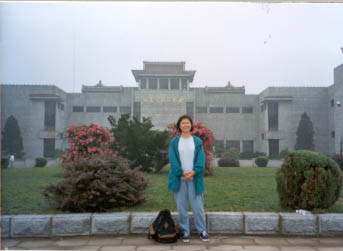
I am in front of the museum of The War to Resist America and Aid Korea. One pays 22 Chinese yuan ($2.75) for admission fee.
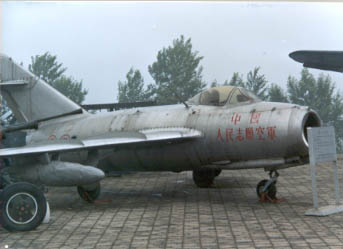
The Chinese People's Volunteers (CPV) plane in display outside the museum. The Chinese characters read "CPV Air Force" which was established in Nov. 1950, barely a month after China entered the Korean conflict. The plane is the Soviet MIG-15. The Chinese pilots were trained by the Soviet pilots.
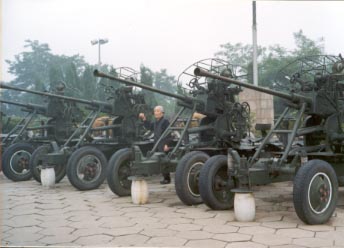
Some types of weaponry used in the war in display outside the museum. An old Chinese lady is posing for picture among them.
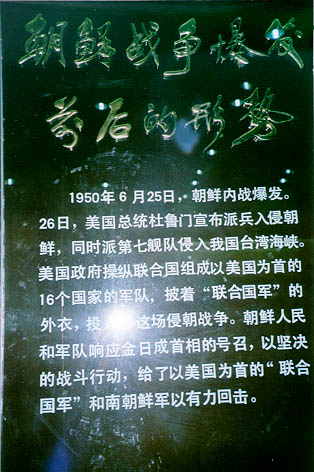
The Chinese official version of the Korean War. The above Chinese
read: "On June 25, 1950, the Korean civil war broke out. On Oct.
26, the U.S. President Truman announced sending [U.S.] troops to invade
Korea and dispatching the [U.S.] 7th Fleet to invade China Taiwan Strait.
The United Nations Command, which consisted of 16 [UN]member nations and
headed by the United States entered the invasion of Korea, under the UN
flag. In responding to the call of their great leader Kim Il Sung,
the [North] Korean people and army put up strong resistance against the
UNC troops and South Korean forces."
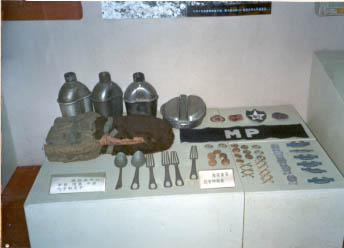
Military supplies from the captured UNC soldiers such as water canteens,
forks and sppons, MP arm bands, and badges, etc.
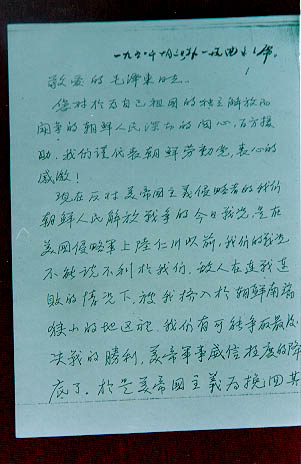
A translated letter in Chinese from Kim Il Sung, the North Korean leader,
to Mao Zedong, the Chinese Communist leader, in Oct. 3, 1950, asking Chinese
support to the North Korean effort in the Korean War. Kim said in
the letter: "On behalf of the Korean Labor Party, I would like to express
our sincere thank to you for your concern of the North Korean struggle
for unification and liberation. The war situation was favorable to
us before the Inchon landing. The enemy was pushed by us to be the
narrow area in southern peninsula (Pusan perimeter). (At that time)
it was possible for us to achieve the final victory. But now the
American imperialist aggressors are trying to turn the table of the war..."
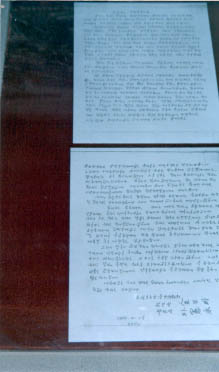
Letter from Kim to Mao in Korean langauge in Oct. 3, 1950.
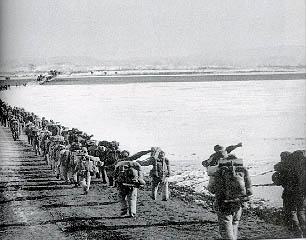
The Chinese military forces, dubbed in the name of the Chinese People's
Volunteers (CPV), crossed the Yalu River on Oct. 25, 1950 to enter
the Korean War on the side of the North Korea People's Army. This
day, Oct. 25 became the CPV day. The Korean War in Chinese term is
known as The War to Resist America and Aid Korea. Or in Chinese
pronounciation: Kangmei Yuanchao Zhanzheng.